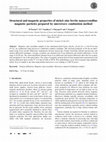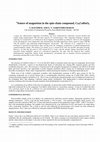Papers by Sudhindra Rayaprol
Physical Review B, 2014
ABSTRACT The intermetallic compound ${\mathrm{Nd}}_{7}{\mathrm{Rh}}_{3}$, which shows two magneti... more ABSTRACT The intermetallic compound ${\mathrm{Nd}}_{7}{\mathrm{Rh}}_{3}$, which shows two magnetic transitions, one at 32 K and another around 16 K, has been known to exhibit a magnetic-field induced first-order magnetic phase transition (FOPT) at low temperatures. Using neutron diffraction we tracked the evolution of the magnetic features as a function of temperature and external magnetic field across the two transition temperatures. We provide evidence for the existence of both antiferromagnetism and ferromagnetism below 20 K. Notably the results reveal concrete evidence for the partial persistence of the high-field magnetic state at 2 K after cycling through the magnetic-field-induced magnetic transition, thereby offering microscopic evidence for magnetic coexistence phenomenon in this intermetallic compound.

Indian Journal of Physics, 2014
Magnetic, nano-crystalline samples of zinc substituted nickel ferrite, (Zn x Ni 1-x Fe 2 O 4 for ... more Magnetic, nano-crystalline samples of zinc substituted nickel ferrite, (Zn x Ni 1-x Fe 2 O 4 for x = 0.0-0.9 in step of 0.2), are synthesized using microwave combustion synthesis technique. The structural properties of Ni-Zn are determined using X-ray powder diffraction, transmission electron microscopy; Fourier transforms infrared spectroscopy and neutron diffraction techniques. Average crystalline size obtained from X-ray diffraction and neutron diffraction is in the range of 30-60 nm. The cation distribution obtained from X-ray diffraction and neutron diffraction show that Zn occupies only tetrahedral A-site in the spinel lattice. The values of magnetic moment derived from magnetization measurements and neutron diffraction agrees nearly 97 % to that of bulk at 300 K. This methodology can be used to prepare large quantities (about 10 g) of sample at one time using kitchen microwave oven working at 1,200 W power.
Inorg Chem, 2010
The germanide EuAuGe was obtained as large single crystals in high yield from a reaction of the e... more The germanide EuAuGe was obtained as large single crystals in high yield from a reaction of the elements in liquid indium. At room temperature EuAuGe crystallizes with the CaAgSi type, space group Fmmm, an ordered variant of the AlB type: a = 857.7(4), b = 1485.5(10), c = 900.2(4) pm. The gold and germanium atoms build up slightly distorted graphite-like
Journal of Superconductivity and Novel Magnetism, 2011
We investigate the effect of ionic size variation on the electrical and thermodynamic properties ... more We investigate the effect of ionic size variation on the electrical and thermodynamic properties in a series of Pr 0.7 Ca 0.3−x Sr x MnO 3 (PCSMO) samples. The increase in Sr content results in an increase of the unit cell volume, as a bigger Sr 2+ ion replaces the smaller Ca 2+ ions. Resistivity measurements show that the increase in the Sr content also results in the induction of a metal-insulator transition (T MI ), which increases with increasing Sr content. The activation energy (E a ), calculated from the resistivity data, decreases with increasing Sr content confirming the metallic character. The effect of the magnetic field on resistivity and specific heat has also been studied.
The results of ac and dc magnetization and heat capacity measurements on the oxides, Ca3Co1+xMn1−... more The results of ac and dc magnetization and heat capacity measurements on the oxides, Ca3Co1+xMn1−xO6, forming in a K4CdCl6-derived rhombohedral quasi-one-dimensional crystal structure, are reported. As far as Ca3Co2O6 is concerned, the results reveal truly complex nature of the two magnetic transitions, identified to set in at 24 and 12 K in the previous literature. However, partial replacement of Co by Mn apparently results in a long magnetic ordering of an antiferromagnetic type (below 13 and 18 K for x= 0.0 and 0.25 respectively), instead of spin-glass freezing in spite of the fact that there is Co-Mn disorder; in addition, interestingly there are hysteretic spin reorientation effects as revealed by isothermal magnetization behavior.
The influence of positive and negative chemical pressure on the magnetic behavior of the compound... more The influence of positive and negative chemical pressure on the magnetic behavior of the compound, Ce 2 RhSi 3 , crystallizing in a AlB 2 -derived hexagonal structure and ordering antiferromagnetically around (T N =) 7 K, is investigated by studying electrical resistivity (ρ) and magnetic susceptibility (χ) behavior of the solid solutions formed by gradual substitution of La/ Y for Ce. While typical features associated with a transformation from the Kondolattice to single-ion Kondo effect are seen in the low temperature ρ data of both the solid solutions, there are profound differences in their behavior at higher temperatures. In particular, Y is apparently more effective in enhancing the Kondo temperature. La 2 RhSi 3 is found to be superconducting below 3 K.
The results of ac susceptibility (χ) measurements for Ca 3 CoXO 6 (X = Rh, Ir and Co) compounds, ... more The results of ac susceptibility (χ) measurements for Ca 3 CoXO 6 (X = Rh, Ir and Co) compounds, containing spin-chains separated by Ca ions, are presented. All these compounds exhibit an unusually large frequency dependence of ac χ in the vicinity of respective magnetic ordering temperatures, which is normally not encountered in conventional spin-glasses. The frequency dependence of ac χ peak temperature is however found to obey Vogel-Fulcher relationship. The results thus establish that these compounds are unusual spin-glasses, that too among stoichiometric compounds presumably due to geometrical frustration.
Physical Review B
ABSTRACT
The spin-chain compounds, Ca 3 CuIrO 6 and Ca 3 CuRhO 6 , crystallizing in a K 4 CdCl 6 -derived ... more The spin-chain compounds, Ca 3 CuIrO 6 and Ca 3 CuRhO 6 , crystallizing in a K 4 CdCl 6 -derived monoclinic structure, are investigated by ac and dc magnetization, isothermal remnant magnetization as well as heat capacity measurements. The results reveal the existence of a magnetic ordering in the vicinity of 15 K for both the compounds, but the transition appears to be of a complex nature. The existence of a spin-glass component is strongly indicated by the results. We propose that topological effects play a role on magnetism of these compounds. The magnetic properties for these two compounds are interestingly similar as though isoelectronic chemical substitution at the octahedral coordination site does not significantly interfere in the magnetic exchange process. PACS numbers: 75.50.Lk, 75.40.Cx, 75.30.Cr, 75.30.Kz

A quasi one-dimensional compound, Ca 3 CuRuO 6 , has been synthesized by solid-state reaction met... more A quasi one-dimensional compound, Ca 3 CuRuO 6 , has been synthesized by solid-state reaction method and studied using magnetization (M) and heat capacity (C) measurements. This compound undergoes magnetic ordering (T o ) around 40 K, as evidenced by the dc magnetic susceptibility (χ) behavior. However, the magnitude of the paramagnetic Curie temperature (θ p ) obtained from the high temperature linear region is large (-277 K, with the negative sign indicating antiferromagnetic interaction). The reduction of T o , compared to θ p , is attributed to geometrical frustration effect arising from the triangular arrangement of antiferromagnetically coupled magnetic chains. The absence of a feature in ac χ around 40 K rules out possible spin-glass freezing. However, we find that the peak in C(T) around 40 K is weak, with the entropy change associated with the transition being negligible, typical of a disordered magnetism. We infer that this material thus exhibits inhomogeneous magnetism, despite being stoichiometric, presumably due to interplay between geometrical frustration and disorder in the Cu-Ru chain.
Materials Letters, 2015
ABSTRACT
Ever since high Tc superconductivity was discovered in La-based mixed oxide system by Bednorz and... more Ever since high Tc superconductivity was discovered in La-based mixed oxide system by Bednorz and Muller, enormous efforts have been put in by several researchers around the world in understanding the origin and mechanism of superconductivity in these, as well as in systems derived from them. It is a proven fact that the superconductivity in RE-123 superconductors is governed by the oxygen content, which in
Solid State Communications
Two modifications of CeCuSn were prepared from the elements: the hightemperature (β) modification... more Two modifications of CeCuSn were prepared from the elements: the hightemperature (β) modification crystallizes directly from the quenched sample, while the low-temperature (α) modification forms after annealing at 700 °C for one month. Both modifications were investigated by X-ray powder and single crystal diffraction. We find for β-CeCuSn a structure of ZrBeSi type, space group P6 3 /mmc, a = 458.2(1), c = 793.7(2) pm, wR2 = 0.0727, 148 F 2 values, 8 variable parameters. In the case of α-CeCuSn we find the NdPtSb type structure, space group P6 3 mc, a = 458.4(1), c = 785.8(2) pm, wR2 = 0.0764, 233 F 2 values, 11 variable parameters. The copper

Journal of Alloys and Compounds, 2015
ABSTRACT Structural analysis of the room temperature diffraction data of Nd2NiGe3 shows that it e... more ABSTRACT Structural analysis of the room temperature diffraction data of Nd2NiGe3 shows that it exhibits AlB2 type structure with space group P6/mmm. The crystal structure of Nd2NiGe3 consists of two dimensional Ni/Ge hexagonal units sandwiching the neodymium atoms between them. Temperature dependent magnetic susceptibility data follows Curie–Weiss law in the temperature range 20–300 K yielding an effective magnetic moment of 3.83 μB/Nd and paramagnetic Curie temperature −2.1 K indicating trivalent Nd and weak antiferromagnetic interactions, respectively. Low field magnetic susceptibility measurement show a weak antiferromagnetic like ordering around 3 K. Temperature dependent neutron diffraction measurements rules out long range antiferromagnetic ordering in this compound. The electrical resistivity measurement shows metallic nature of Nd2NiGe3, which exhibits sudden drop in resistivity below 3 K.

ChemInform, 2010
ABSTRACT The germanide Eu(2)AuGe(3) was obtained as large single crystals in high yield from a re... more ABSTRACT The germanide Eu(2)AuGe(3) was obtained as large single crystals in high yield from a reaction of the elements in liquid indium. At room temperature Eu(2)AuGe(3) crystallizes with the Ca(2)AgSi(3) type, space group Fmmm, an ordered variant of the AlB(2) type: a = 857.7(4), b = 1485.5(10), c = 900.2(4) pm. The gold and germanium atoms build up slightly distorted graphite-like layers which consist of Ge(6) and Au(2)Ge(4) hexagons, leading to two different hexagonal-prismatic coordination environments for the europium atoms. Magnetic susceptibility data showed Curie-Weiss law behavior above 50 K and antiferromagnetic ordering at 11 K. The experimentally measured magnetic moment indicates divalent europium. The compound exhibits a distinct magnetic anisotropy based on single crystal measurements and at 5 K it shows a metamagnetic transition at ∼10 kOe. Electrical conductivity measurements show metallic behavior. The structural transition at 130 K observed in the single crystal data was very well supported by the conductivity measurements. (151)Eu Mössbauer spectroscopic data show an isomer shift of -11.24 mm/s at 77 K, supporting the divalent character of europium. In the magnetically ordered regime one observes superposition of two signals with hyperfine fields of 26.0 (89%) and 3.5 (11%) T, respectively, indicating differently ordered domains.
Ceramics International
FeMnO3 prepared by mechano-synthesis method using high energy planetary ball mill crystallizes in... more FeMnO3 prepared by mechano-synthesis method using high energy planetary ball mill crystallizes in bixbyite type cubic structure in space group Ia3. Magnetic measurements show that the compound is ferrimagnetic at room temperature and on cooling undergoes antiferromagnetic ordering around 36 K. Magnetization measurements exhibit strong magnetic anisotropy in this system. Change in the magnetic entropy, also known as the magnetocaloric effect, has been observed in FeMnO3 on subjecting the sample to a changing magnetic field. We found maximum change of magnetic entropy~1.5 J/kg·K, for a field change of 90 kOe at T~2To with relative cooling power of 50 J/kg.
ChemInform
The title compound is prepared by arc melting of stoichiometric amounts of the elements followed ... more The title compound is prepared by arc melting of stoichiometric amounts of the elements followed by annealing (1173 K, 10 d).








Uploads
Papers by Sudhindra Rayaprol